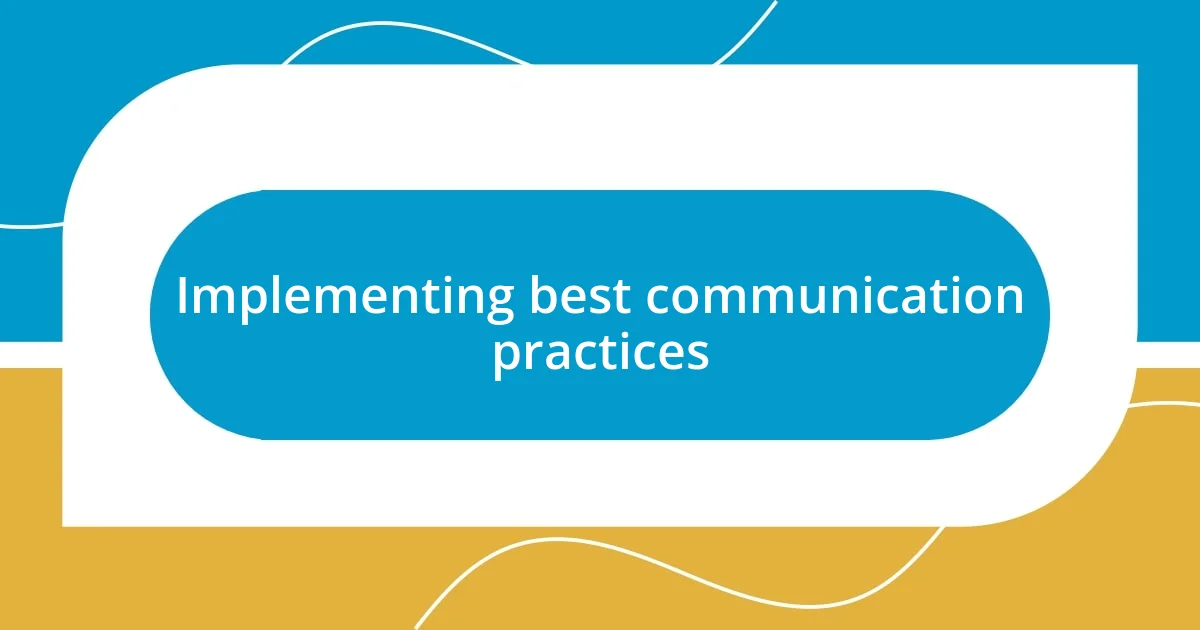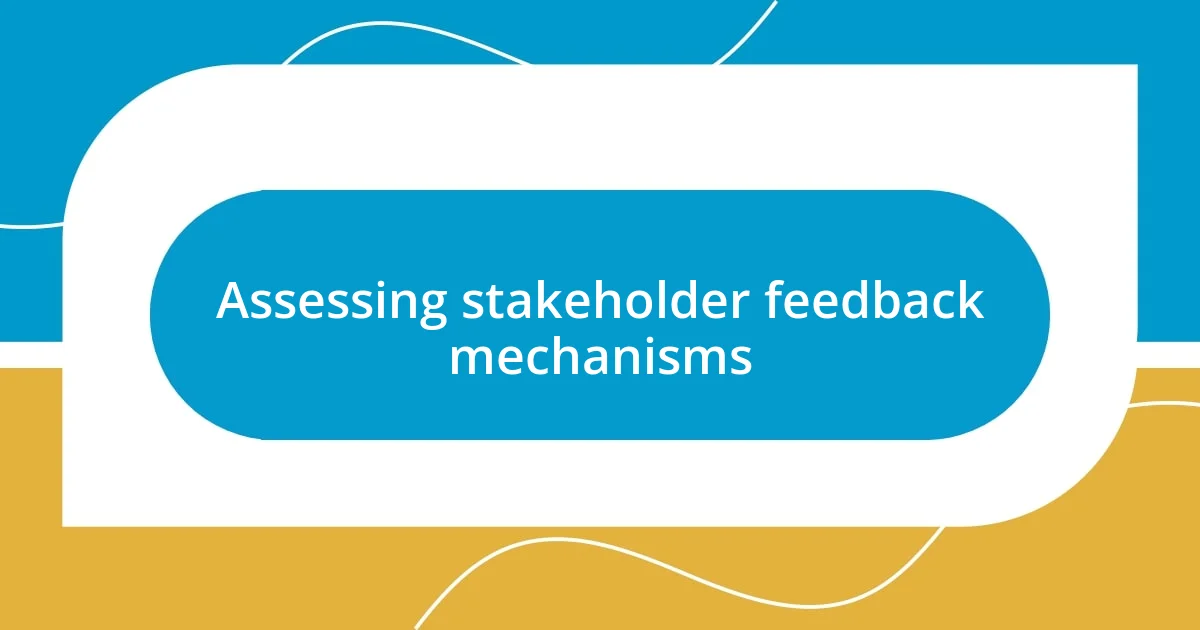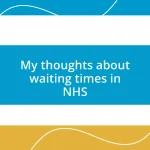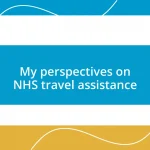Key takeaways:
- Effective communication in the NHS is essential for building trust, understanding emotional needs, and catering to diverse patient backgrounds.
- Current communication strategies face challenges such as information overload, cultural sensitivity, and the need for consistent feedback mechanisms and staff training.
- Innovative approaches, like community outreach, digital platforms for feedback, and immersive technologies, can significantly enhance patient communication and care experiences.

Understanding NHS communication needs
Understanding NHS communication needs is crucial in fostering trust between patients and healthcare providers. I remember a time when my grandmother needed to understand her treatment options after a hospital visit. The clarity of communication was vital; without it, anxiety and confusion can easily take hold. How often do we overlook the simple but profound impact that clear dialogue can have on a patient’s experience?
The NHS must recognize that communication isn’t just about sharing information; it’s about conveying empathy and support. I once sat in on a consultation where the doctor took extra time to explain the medical jargon, transforming what could have been a faceless exchange into a comforting conversation. Isn’t it fascinating how the right words can not only inform but also heal?
Moreover, considering diverse backgrounds and languages within the NHS communication strategy is essential. I’ve witnessed firsthand how a bilingual nurse was able to connect with a family struggling to understand their child’s condition, bridging a significant gap. Such interactions highlight that effective communication extends beyond mere facts; it taps into the emotional and cultural significance of healthcare experiences.

Evaluating current NHS strategies
Evaluating the current NHS communication strategies reveals both strengths and weaknesses. One of the core strengths lies in the NHS’s commitment to transparency; information about services and treatments is generally accessible online. I recall browsing the NHS website while researching a recent health concern of my own. The information was straightforward, yet I wished for more personalized guidance to help me navigate the overwhelming amount of data.
On the flip side, challenges in communication remain, particularly when it comes to understanding patients’ emotional needs. The following points outline some key areas of focus in the evaluation process:
- Information Overload: Patients often receive too much technical detail without adequate context.
- Cultural Sensitivity: Strategies must improve to cater to the diverse populations served by the NHS.
- Feedback Mechanisms: Increasing patient feedback could enhance the responsiveness of communication approaches.
- Training for Staff: Ongoing training for healthcare professionals can better equip them to connect with patients effectively.
- Use of Technology: Incorporating user-friendly digital tools could streamline communication and enhance patient experience.
By addressing these areas, the NHS can promote a more empathetic and effective communication strategy that genuinely resonates with patients. Each interaction holds the potential to foster trust and understanding, and that’s something I genuinely believe can transform patient care.

Identifying key communication challenges
Identifying key communication challenges in the NHS is essential for improving patient experiences. One hurdle I’ve noticed is the gap between healthcare professionals and patients due to medical terminology. I recall feeling lost during a discussion about a diagnosis when the doctor started using terms that flew right over my head. A simpler, more relatable approach could transform such moments and ease patient anxiety.
Another significant challenge lies in reaching diverse patient populations. During a visit to the clinic, I witnessed how well a staff member facilitated communication with a non-English speaking patient through an interpreter. It struck me then—while this was a great solution, not all facilities have equipped themselves similarly. Addressing language barriers can significantly impact the quality of care and patient satisfaction.
Lastly, I think about the emotional aspect of communication. I’ve been in situations where compassion seemed to take a back seat during rushed consultations. When healthcare professionals prioritize emotional connection alongside clinical details, it fosters trust and encourages patients to voice their concerns more freely. Isn’t it vital that patients feel heard, especially when dealing with health challenges?
| Challenge | Description |
|---|---|
| Medical Jargon | Patients often misunderstand complex terminology, leading to confusion and anxiety. |
| Diverse Populations | Catering to different languages and cultures remains a significant hurdle for effective communication. |
| Emotional Connection | Rushed consultations can neglect the necessary compassion in patient interactions. |

Exploring successful case studies
Exploring effective communication strategies within the NHS, I can’t help but think of a particular initiative that impressed me deeply. I recall a community health program that used local outreach to engage residents directly. By organizing workshops in community centers, they not only shared important health information but also encouraged open dialogue. This approach captivated me; it felt less like a lecture and more like a conversation among neighbors, making healthcare seem more approachable.
One case study that stands out is the implementation of a pictorial health guide in a pediatric ward. During a visit with my niece, I noticed how the colorful visuals and friendly characters helped children understand their treatments without the dread of complicated medical explanations. It sparked a joy in the kids as they interacted with the material, turning what could be a scary experience into something relatable. I found myself wondering: how impactful could such strategies be if adopted across all departments?
I’ve also come across a digital platform that was designed specifically for patient feedback. After a recent health visit, I received an email prompting me to share my experience in a simple, engaging format. Reflecting on my responses, I realized how this not only made me feel valued but also allowed me to have a voice in the healthcare conversations that truly matter. It made me ask: if patients feel heard, wouldn’t they be subsequently more likely to trust and engage with the service?

Implementing best communication practices
Implementing best communication practices requires a focus on clarity and empathy. I once attended a health seminar where the speaker emphasized using plain language instead of medical jargon. It was a game-changer! I remember how much easier it was to grasp concepts when relatable examples were used, rather than getting lost in a sea of complex terms. Isn’t education at its best when it’s truly accessible?
Building trust is also vital in communication, especially in healthcare settings. I recall a particularly memorable consultation with a nurse who took the time to not only explain my treatment plan but also check in on my feelings regarding it. That small act of genuine interest made me feel valued as a patient and inspired me to ask questions I hadn’t thought to voice before. Wouldn’t it be wonderful if every patient had that kind of encouraging interaction?
Lastly, feedback loops can be transformative. During a follow-up appointment, I was pleasantly surprised when my doctor asked for my thoughts on a new procedure. I didn’t expect my opinion to matter so much, and it struck me how empowering that felt. Creating a system that actively seeks patient input can lead to improvements that benefit everyone. After all, don’t we all want our experiences to shape the care we receive?

Assessing stakeholder feedback mechanisms
Assessing stakeholder feedback mechanisms is crucial for understanding how well healthcare services meet patient needs. I vividly remember attending a community health meeting where participants shared their experiences and suggestions. It struck me how powerful it was for attendees to voice their opinions in an open forum, creating a dynamic dialogue that truly captured the essence of community involvement. Isn’t it fascinating how these kinds of discussions can lead to real change?
In my experience, digital surveys have also emerged as effective tools for gathering feedback. After a recent consultation, I received a short survey on my phone, which felt convenient and non-intrusive. To my surprise, I found myself genuinely reflecting on my experience, realizing that my insights could directly influence future practices. It made me wonder: how many patients actually take time to provide feedback if the process is easy and accessible?
However, I believe there’s something special about face-to-face interactions in feedback mechanisms. During a care review session, for instance, I witnessed how simply sitting down and having an honest conversation with healthcare professionals allowed for deeper insights. It was evident that the emotional connection in these conversations fostered a sense of trust and openness. Could it be that the most effective feedback strategies are those that prioritize personal connections over impersonal forms?

Future directions for NHS communication
Exploring future directions for NHS communication is exciting, especially as technology continues to evolve. Imagine a scenario where virtual reality is used to prepare patients for procedures. I once experienced a virtual tour of a hospital setting before a minor surgery, and it was incredibly reassuring. Can you envision how immersive technologies could further demystify medical environments for anxious patients?
Moreover, integrating social media strategies into NHS communication could bridge the gap between healthcare providers and the public. I remember how a local health service used Twitter to share health tips and answer real-time queries. It made those resources more accessible and fostered a sense of community. Have you noticed how platforms like these can create a more interactive and informed patient population?
Finally, enhancing cultural competence in communication will be essential for the NHS as it continues to serve diverse communities. During a community health fair, I witnessed how workshops tailored to specific cultural needs not only educated attendees but also fostered trust and understanding. Isn’t it empowering when healthcare providers genuinely reflect the community they serve? By prioritizing these approaches, the NHS can enhance its relevance and responsiveness to everyone.












